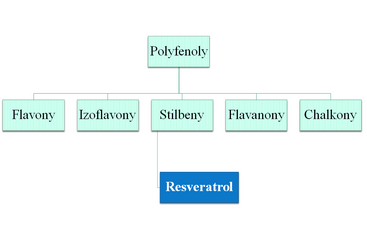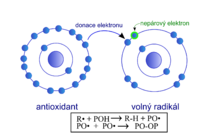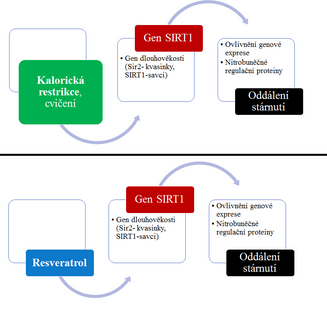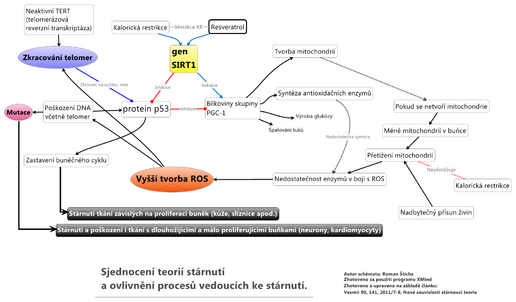Resveratrol
Resveratrol (trans-3,5,4´-trihydroxystilbene) and other polyphenolic substances present in natural materials are currently at the forefront of world interest due to their beneficial effect on the human body. These substances are antioxidants . Their action is associated with a positive effect on fat metabolism and a reduction in the number of cardiovascular and cancer diseases.
Recently, the effect of resveratrol has also been associated with effects similar to the caloric restriction. Caloric restriction is considered a possible way to prolong an individual's lifespan (more details below).
Chemical structure[edit | edit source]
Resveratrol (3,4 ', 5-trihydroxystilbene, C 14 H 12 O 3 ) belongs to the group of substances called polyphenols . This group of substances is characterized (as the name implies) the presence of more OH groups. It is the number of OH groups that give polyphenols their considerable antioxidant significance .
Classification of polyphenols Due to the presence of a double bond on the side chain, resveratrol forms two geometric isomers (cis / trans isomerism). A mixture of both isomers occurs in plants , where the trans-form predominates .
Occurrence in nature[edit | edit source]
In nature, resveratrol is found in a variety of plants. These are, for example: Chinese cabbage, broccoli, chicory, garlic, carrots, parsley, onions, green tea or groundnuts (peanuts). The concentration of resveratrol in these substances ranges from 2-15 mg.kg -1 . However, the most important natural source of resveratrol is grapes . In some varieties of red wine, the concentrations are around 28 mg.kg -1 . Such a high concentration can be found, for example, in the Pinot Noir variety . It is interesting that white wine or its grapes do not show such high values.
Significance in the plant[edit | edit source]
The plant produces resveratrol in response to a stressful situation or an attack by a parasite (fungus, bacteria). It creates a so-called resveratrol barrier, which protects it from the oxidative effects of parasite metabolism. The highest concentration of resveratrol is evident not directly at the site of infection, but in its immediate vicinity.
Resveratrol as an antioxidant[edit | edit source]
Due to the presence of OH groups in its structure, resveratrol is considered an important antioxidant . OH groups show an affinity for the unpaired electrons of the radical and thus reduce their reactivity. However, this creates an unpaired electron within the O of the original OH group of the antioxidant. This generated unpaired electron within the electron shell of the oxygen atom of the original OH group is compensated by sharing the electrons with another O, which is in the same situation, so the PO-OP bond is formed.
Calorie restriction[edit | edit source]
Calorie restriction[edit | edit source]
Caloric restriction has a positive effect on life expectancy in many organisms. This effect is manifested in yeasts as well as in octopus flies, Caenorhabditis elegans nematodes or laboratory mice and rats. If these organisms are reduced by 30 to 50% below normal levels while maintaining all other food components, then their life is extended by up to half.
Reduced energy intake leads to metabolic changes and modification of gene expression in the body. In relation to prolonging life, the increased expression of so-called longevity genes - Sirtuins (especially in yeast, one of these genes is called Sir2, in mammals its homologue is called SIRT1) is especially important. This phenomenon has been studied mainly in yeast, octopus flies, nematodes Caenorhabditis elegans.
However, there are other factors that contribute to prolonging the life of the body in case of caloric restriction. For example, less mitochondrial loading leads to reduced formation of free radicals that otherwise damage tissue cells. In the larvae of Caenorhabditis elegans, a transition to a certain "saving mode" has also been observed.
Minimal Calorie restriction[edit | edit source]
The question arises as to whether the effect of caloric restriction in the body could be "triggered" other than by a reduced amount of food. It has been found that some substances do. Many of them come from natural sources. There is an effort to isolate such a substance and possibly introduce synthetic production. An example of such a substance is resveratrol.
Thus, resveratrol is a substance capable of mimicking the effect of caloric restriction in the body - the mimicry of caloric restriction by resveratrol.
For example, prof. David Sinclair. His experiment with laboratory mice is known, where he compares the activity of 3 mice, which serves as an indicator of the progression of aging to compare the effect of resveratrol on the mouse organism. The resveratrol-treated mouse shows higher muscle activity and endurance.
Linking theories of aging[edit | edit source]
As already mentioned, resveratrol is an anti-aging agent. But the question is, what causes aging and what do substances like resveratrol affect?
There are several theories of aging , but there is an effort to unify them and create a unified theory. The attached diagram shows the effect of tissue aging. Generally speaking, tissues age because the cells that make them do not recover fast enough. On the other hand, there are tissues that are less dependent on cell proliferation, such as nerve tissue and the myocardium . But what causes the aging of these tissues? Oxidative damage ( free radicals ) is the most offered), accumulation of mutations and subsequent damage to the internal functions of cells, their metabolism , etc.
So tissues age in two ways[edit | edit source]
- Insufficient recovery due to reduced proliferation (mucosal cells, skin cells and others).
- Death of long-lived cells ( neurons , cardiomyocytes ) that no longer regenerate.
Mechanisms of aging[edit | edit source]
In principle, the mechanisms of aging include the following processes:
- Free radical damage ( ROS , reactive oxygen species);
- Gene equipment - "aging" genes, "longevity" genes;
- Telomere shortening during splitting;
- Mutations in the genome - ultimately induces apoptosis of the damaged cell.
Schematic description[edit | edit source]
The following diagram shows the context in the processes affecting aging.
- The key role here is played by the p53 protein (the so-called Guardian of the Genome), which is overexpressed when DNA is damaged and when the telomeres are shortened below a certain threshold. The result of its action is that it induces apoptosis , ie cell death. Faulty or overexpression of this protein results in premature cell death.
- As can be seen from the figure, the action of the p53 protein is affected by certain genes. For example, longevity genes, such as the SIRT1 gene in mammals . As already mentioned, these genes can be affected by certain substances, such as resveratrol . The expression of these genes is also stimulated by caloric restriction .
- Through other genes and their products, the expression of the SIRT1 gene is stimulated by PGC-1 proteins , which have the following effects: increase the synthesis of proteins important for mitochondrial formation, support the synthesis of antioxidant enzymes (positively affect radical control) and affect carbohydrate and fat metabolism.
- Sufficient mitochondria lead to reduced ROS production because they are not overloaded. In other words, they have enough antioxidant enzymes due to their activity.
- The result of this action is reduced oxidative stress on the cell. Thus, even cells that do not proliferate so intensively ( neurons , cardiomyocytes) are spared damage , ie aging. Of course, reduced radical damage also has a positive effect on proliferating cells.
Use in practice[edit | edit source]
Today, resveratrol is used as a dietary supplement, which is used for its antioxidant properties and, more recently, due to the aforementioned effects on possible life extension. It is available on the market in the form of several products, of which the most common in our territory is Evelor, which contains 50 mg of resveratrol. This supplement is dosed only once a day and the price of its 90 tablet pack is around 660 CZK. Another product available in our territory is Resveratrol (250 mg, 60 tablets), which is offered for CZK 780.
Thoughts on conculsion[edit | edit source]
However, the awareness of resveratrol in our country is not very high and therefore the market is not very focused on this product yet. However, abroad, especially in the USA, resveratrol is a required commodity. We can thus most likely expect that in the coming years we will see increased interest in these products in our region as well, as the desire for health and immortality has accompanied humanity since time immemorial and it cannot be assumed that in our time it should be otherwise.
Links[edit | edit source]
Related Articles[edit | edit source]
- Aging organism
- The difference between average and maximum life expectancy
- Antioxidant protection of the human body
Reference[edit | edit source]
- KOLOUCHOVA, Irena. Resveratrol as a biologically active substance and its importance for human health. Prague, 2004,
- ↑ KOLOUCHOVA, Irena. Resveratrol as a biologically active substance and its importance for human health. Prague, 2004
- ↑ KOLOUCHOVA, Irena. Resveratrol as a biologically active substance and its importance for human health. Prague, 2004
- ↑ Medical Tribune. Specifics of caloric restriction in humans [online]. © 2008. [feeling. 2013-03-16]. < https://www.tribune.cz/clanek/12737 >.
- ↑ David Sinclair at TEDMED Discussing Resveratrol, Longevity, Endurance, and Sirtuins; https://www.youtube.com/watch?v=DekHXlnXAwk
- ↑ Universe 90, 141, 2011 / 7-8, New contexts of aging theory
- ↑ https://www.mediexpert.cz/search/?w=resveratrol&submit.x=-1121&submit.y=-141
- ↑ http://www.superberry.cz/resveratrol-p6
References[edit | edit source]
- MAROON, Joseph C and Kateřina ORLOVÁ. Longevity factor: both resveratrol and red wine activate the genes for a longer and healthier life. 1st edition. In Bratislava: NOXI, 2010. ISBN 978-80-8111-031-3 .
- NOVOTNÁ, Božena and Jaroslav MAREŠ. Developmental biology for medics. 1st edition. Prague: Karolinum, 2005. 99 pp. ISBN 978-80-246-1023-8 .





